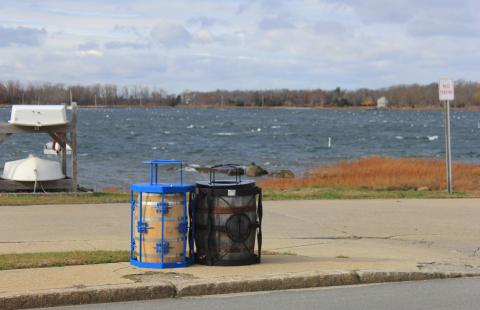What were the specific goals of this creative economy project? Describe the community development challenge or opportunity that your project was designed to address:
- Create a sense of Place
- Beautify neighborhoods
- Improve quality of life for all through improved aesthetics, more and safer bicycling and walking opportunities
- Create a greater sense of community that celebrates the neighborhood’s heritage
- Employ local artists
- Train Weld to Work participants
- Reinvest in the local economy by working with local industry partners when feasible.
- Be an Economic Multiplier.
- Design and make high quality products that both serve as public art, and work well for the municipality (DPW) and community.
Our artistic street amenities were designed to improve the experience of Bristol as a pedestrian and/or biker. Our trash and recycling cans replaced old, heavy trash cans. Our additions of bike racks and benches allowed for bike parking and provided places to rest. The lamp post decorative medallions on Wood Street celebrate the culture of the neighborhood.
If the goals change over time, please describe how:
- Shift focus from Hope Street area to Wood Street. Distinguish one from the other, as they have very different characters.
- Specifically, make our first ever line of side-opening trash cans to improve the experience of emptying the cans.
- Include/Encourage recycling
Who was involved in this project and what did they do? (be sure to include the partners from outside of the creative sector and how local voices were included):
- The Steel Yard: Serve as project manager. We employ artists from the RI community to design and fabricate the amenities, give them access to our guidance, facilities, and cover them under our insurance, allowing artists to do this work without needing their own shop or liability insurance. Ensure safety and code compliance of projects, manage installation, maintain client relationships.
Town of Bristol, Department of Planning and Community Development: Diane Williamson (Director) and Ed Tanner (Principal Planner/Zoning Officer). The Town funded a significant portion of the projects through their own budget, but also applied for large grants to cover the bulk of the costs. During the design and planning process, they also serve as conduits to the community and other municipal branches, and assist in selecting the locations of the pieces.
- Bristol Department of Public Works: Responsible for emptying trash cans, general maintenance. Provide feedback during design phase.
- Business/Neighborhood Associations for both Hope Street and Wood Street: Provide feedback on designs, express desires of community members.
- Local RI Artists and trainees from our weld to work program: Do the amazing work of designing and fabricating!
- Mosaico Community and Business Development Corporation: Diana Campbell, Director. Crucial participation in initiating and advocating for Wood Street improvements, raising money to fund first ever Wood Street project (Fence around Bristol Industrial Park), provide history of the neighborhood, contribute to design decisions.
How does this project relate to a larger community development strategy?
Our work with Bristol directly relates to the larger community development strategy of improving the Town’s walkability, bikeability and beautification. Walking and Biking audits have been completed, with a plan to create a Bristol Bicycling Map for residents and visitors. Our work also inadvertently supports the work of the Bristol Health Equity Zone (collaborative neighborhood groups funded by the RI Department of Health to improve community health from a holistic perspective), which has also focused much of their efforts on Wood Street. Our designs, influenced by the surrounding architecture, accentuated the industrial culture of the neighborhood, which was important to the Town.
What projects or places, if any, inspired your approach to this creative economy project?
Our approach to these projects builds off of all our previous projects, which we have been doing since 2007.
